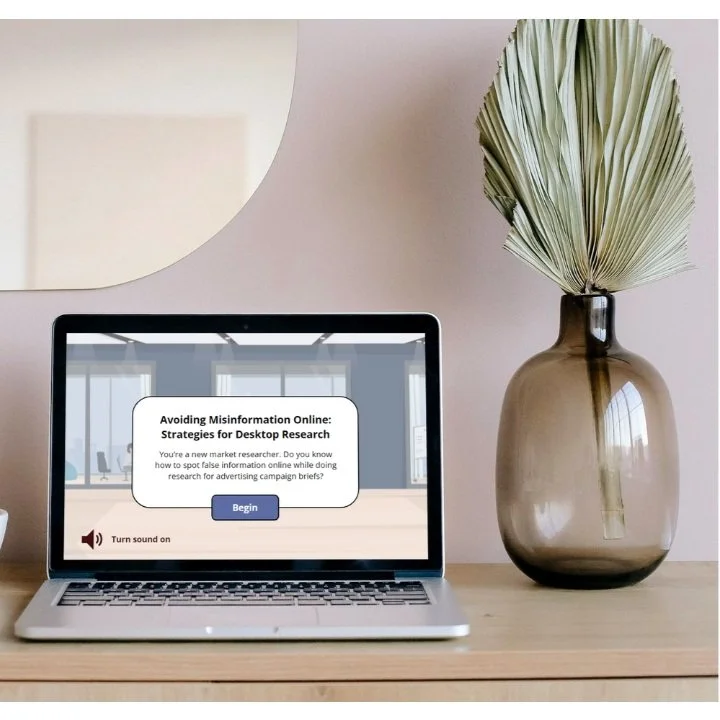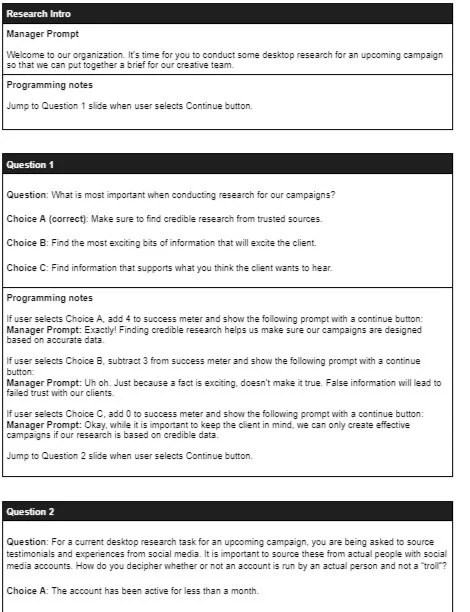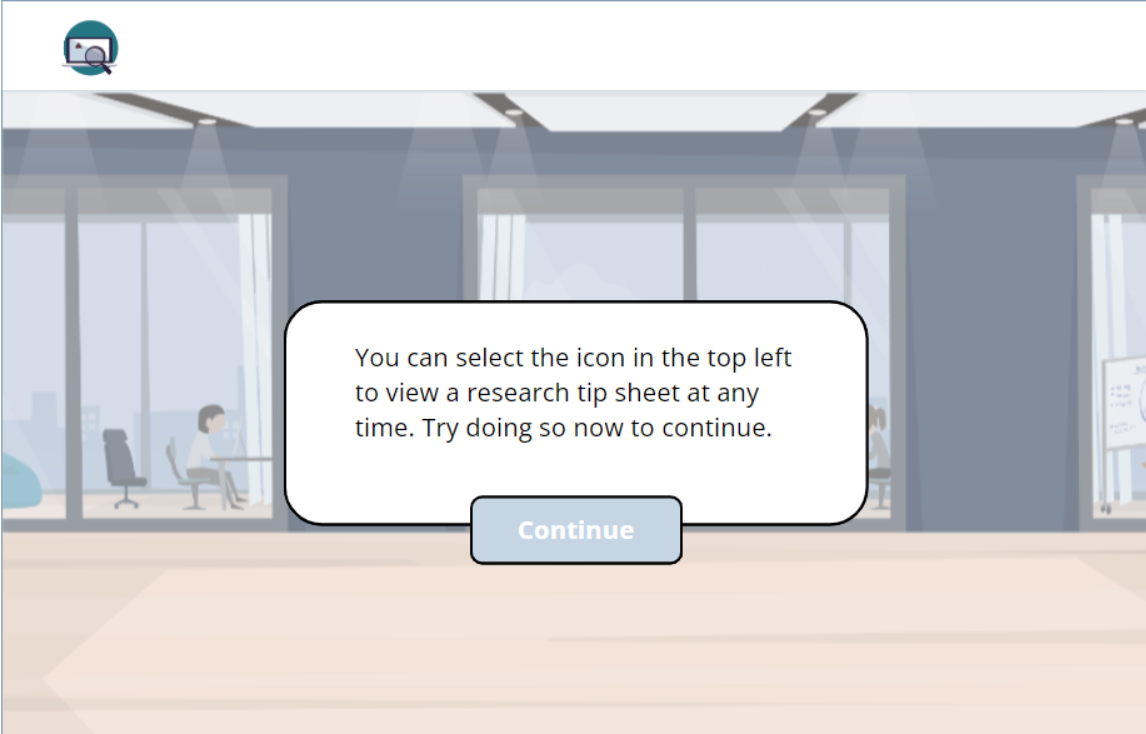Avoiding Misinformation Online: Strategies for Desktop Research
This scenario-based eLearning experience helps market researchers to source credible data when doing desktop research for advertising campaign briefs. It lays the groundwork for actual research a new market researcher would have to do for campaign briefs.
Audience: New market researchers at an advertising agency.
Responsibilities: Instructional Design, Action Mapping (Needs Analysis), Storyboarding, Visual Design, Mockups, eLearning Development
Tools Used: Articulate Storyline 360, Vyond, Adobe XD, Adobe Illustrator, MindMeister, Canva, Audacity, Google Docs
The Problem and the Solution
AdBest Agency (a fictitious ad agency created for the purpose of this concept project) is dismayed that their recently hired market researchers have repeatedly sourced misinformation when doing desktop research for upcoming campaigns. Desktop research is vital to the agency because the information the researchers gather informs the agency’s client creative briefs and ultimately informs the final advertising campaigns. This is a pain point because if misinformation makes its way into briefs, it can cause the client to lose trust in the agency. If no one catches the misinformation, it can also cause the resulting campaign to be based on false data. All of this can lose the agency business and profits.
I recommended scenario-based as that would allow new market researchers to practice their skills at identifying misinformation before working on another brief. This eLearning experience would also demonstrate probable consequences for failing to identify misinformation in future campaigns.
Process
After assessing the problem, I met with a Subject Matter Expert (SME) who is an advertising executive and understands firsthand the ramifications of misinformation in her industry. I also used myself as Subject Matter Expert for avoiding misinformation online, as I had previously designed and facilitated courses on this subject. I relied on the ADDIE model and also iterated at each stage of development. My process including action mapping, writing a text-based storyboard, designing visual mockups, creating an interactive prototype, and completing the full development of the project.
Action Mapping
With the help of the advertising Subject Matter Expert, I used MindMeister to create an action map to help guide the development of this project and determine clear and actionable goals for market researchers to attain. We identified the main misinformation pitfalls researchers encounter and determined what they needed to learn to avoid these missteps.
Text-based Storyboard
Once the action map had focused my efforts toward actionable goals for new market researchers, I began developing the text-based storyboard in Google Docs.
It was a priority to include learner feedback after answer selection and to demonstrate real consequences for misinformation in advertising research. The learner would experience positive reinforcement from colleagues for selecting the correct answer choice.
I consulted with the SME to ensure that the research scenarios in each question were consistent with researcher job duties.
Visual Mockups
After approval of the text-based storyboard, I moved on to work on mocking up a visual design for the project. I settled on a color scheme that evoked a professional yet inviting setting.
I used Adobe Illustrator to customize free, attribution-free vector illustrations that I sourced from a stock image library. I customized these assets to align with the color scheme and cleaned up extraneous details to simplify icons and images for the project.
I created the visual mockups in Adobe XD, which allowed me to easily iterate on the design of the various types of slides.
I made sure fonts, colors, characters, buttons, text boxes, and other illustrations would maintain a consistent and engaging visual style.
Interactive Prototype
Once a visual design guide had been established, I used Articulate Storyline to develop an interactive prototype.
For the prototype, I created an introductory slide, a slide introducing the tip sheet job aid that is available to learners throughout the course. I created the job aid in Canva and made it so it could be downloaded or accessed by clicking on a tip sheet icon. I also introduced a slide meter to help learners track their progress through the course.
For the interactive prototype, I also created initial animation in Vyond of the new market researcher’s manager explaining the task. As a part of the prototype, I also developed the first question slide as well as the branching answer scenarios.
Full Development
Based on feedback during the interactive prototype stage, I added audio to the introductory slides and also audio to the animation slides. I recorded myself using audacity reading the supervisor’s lines and found royalty free office ambience side effects to add realism to the office environment depicted in the slides. I used Vyond to develop the rest of the animation and Articulate Storyline 360 to develop the rest of the eLearning project.
Features
Visuals - I sourced vector illustrations from an image library and created a distinctive and consistent design by manipulating those assets in Adove Illustrator. I enjoyed iterating on the design and prototype in Adobe XD and Articulate Storyline 360.
Engaging Sound Effects - I sourced royalty-free sound effects and used Audacity to record narration for animated moments in the learning experience. The audio elements help create a more immersive and engaging learning experience.
Downloadable Job Aid - I designed a job aid that acts as a quick reference for three main tenets of avoiding misinformation when doing desktop research. I used Canva, a program I was already experienced with, to design the document, but I imported custom visuals that I edited in Illustrator. This document is meant to serve as a convenient reference for learners after the learning experience ends.
Gamification - Success Meter - In order to help learners stay engaged and to track their own progress with these skills, I created a success meter that moves up and down toward “thumbs up” or “thumbs down” depending on whether learners answer correctly or not. I found these visuals to be a simple yet effective shorthand for positive and negative progress through the learning experience.
Results & Takeaways
I conducted final testing by having the SME and a network of instructional designers complete the eLearning experience. Based on their feedback, I completed final tweaks, such as adjusting some of the audio components, addressing a button’s functionality on one of the slides, and adding a “Sound On” notice to the introductory slide. Feedback was positive and the advertising executive noted they thought this would be an excellent tool for new market researchers.
This project afforded me the opportunity to work with a SME and to gain invaluable experience with Articulate Storyline 360. I also learned more about using Vyond for animations, Adobe XD for efficient design and prototyping, and Adobe illustrator for asset manipulation.










